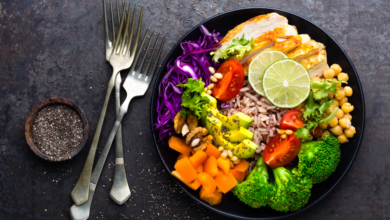Simple Principles: The Definitive Healthy Eating Guide for Real Life
Healthy Eating Guide

In a world overwhelmed by fad diets, calorie counting, and complex eating rules, the concept of “healthy eating” can seem overwhelming. However, Healthline simplifies this view, arguing that optimal nutrition does not have to be complicated, nor does it require following a specific eating plan, but rather prioritizing the right fuel for the body.
Healthy eating essentially means nourishing your body with nutrient-dense foods, avoiding fear, obsessive counting, and constant tracking. Food should be enjoyed, not feared.
This definitive Healthy Eating Guide distills the essential principles of nutrition, focusing on nutrient density, diversity, and the importance of simplifying your relationship with food for lasting physical and mental health.
LEIA TAMBÉM:
- Exercício rápido para aliviar a dor lombar: movimentos simples que funcionam
- Correr ajuda a perder peso? Como começar e progredir sem perder o fôlego
Siga nossa PÁGINA
The Pillars of Smart Nutrition
Instead of focusing solely on calories or following restrictive diets, the Healthline article suggests focusing on three fundamental concepts:
Nutrient Density
Although calories are important, the primary concern should be nutrient density. This refers to the amount of nutrients (proteins, carbohydrates, fats, vitamins, and minerals) a food provides in relation to the calories it contains.
- Practical Example: Foods like nuts, Greek yogurt, avocado, and fatty fish may be high in calories, but they are extremely dense in essential nutrients. On the other hand, foods low in calories but without significant nutrients (like highly processed snacks) are not a healthy choice.
- General Rule: Prioritize foods rich in protein, fiber, healthy fats, vitamins, and minerals. This includes vegetables, fruits, seeds, beans, fatty fish, and eggs.
Diet Diversity
A diet rich in different types of food is fundamental. Diet diversity supports your gut microbiome (beneficial bacteria), promotes a healthy body weight, increases longevity, and protects against chronic diseases.
- Practical Tip: If you find it difficult to try new foods, start by adding a favorite vegetable to one or two meals a day. Research shows that the more you are exposed to a food, the greater the chance of growing accustomed to it.
Macronutrient Balance
Macronutrients are protein, carbohydrates, and fat. Your meals and snacks should generally be balanced between the three. Balance not only makes dishes tastier but also increases the feeling of satiety.
- The Rule of Threes: To avoid drawing a blank at mealtime, think in terms of:
- Protein: Eggs, chicken, fish, tofu.
- Fat: Nuts, seeds, nut butter, avocado, cheese, or Greek yogurt.
- Fiber-Rich Carbs: Sweet potatoes, oats, certain fruits, and beans — or low-carb fiber sources like asparagus, broccoli, cauliflower, and berries.
- Note: Counting macros and following a rigid plan is unnecessary for most people and can lead to an unhealthy fixation on food. Simply choose whole, healthy foods.
What to Avoid (and What to Accept)
One of the most effective ways to improve your diet is to cut back on ultra-processed foods.
- Ultra-Processed Foods: Products like sodas, sugary packaged snacks, and sugary cereals contain little to no whole food ingredients. Diets high in these foods are linked to an increased risk of chronic diseases, weight gain, and even depressive symptoms.
- Processed Foods: It is not necessary to avoid all processed foods. Many healthy foods, such as shelled nuts, canned beans, and frozen fruits and vegetables, have been processed in one way or another but retain their nutritional value. The key is to avoid the ultra-processed ones.
Strategies for a Healthy Relationship with Food
For healthy eating to work, you need to make it a priority, but in a sustainable way:
1. Stock the Kitchen
A well-stocked kitchen makes healthy choices easier. When grocery shopping, ensure you have:
- Fruits and Vegetables: Fresh and frozen.
- Protein Sources: Chicken, eggs, fish, tofu.
- Bulk Carb Sources: Beans, whole grains, sweet potatoes.
- Fat Sources: Avocado, olive oil, full-fat yogurt.
- Simple Snacks: Nuts, seeds, hummus, olives.
2. Cook at Home
Cooking at home helps diversify your diet and control ingredients. If you are used to ordering takeout, start by cooking just one or two meals a week and gradually increase.
3. Progress, Not Perfection
It is essential to realize that your diet will not be perfect. Progress, not perfection, is key. If you currently eat out every night, cooking one homemade, veggie-packed meal a week is significant progress.
4. Smart Hydration
Staying hydrated is part of healthy eating. Water is the best option. If you are not used to plain water, use a reusable bottle and add fruit slices, cucumber, or a squeeze of lemon for flavor.
5. Honor Your Dislikes
If you have tried a specific food several times and don’t like it, don’t force yourself to eat it. There are countless healthy options to choose from instead. Eating healthy does not mean eating something you hate just because it is considered “healthy.”
6. Eliminate Cheat Days
The concept of “cheat days” or “cheat meals” is a sign that your diet is too unbalanced and restrictive. When you learn that all foods can be part of a healthy diet (with moderation and balance), there is no need to “cheat” the system.
Conclusion
The Healthline Healthy Eating Guide offers a liberating approach: a balanced diet is one that is rich in nutrient-dense foods, low in ultra-processed products, and composed of meals and snacks that promote satiety.
By focusing on the principles of density and diversity and simple strategies like smart kitchen stocking and cooking at home, it is possible to develop a healthy and sustainable relationship with food that benefits both your physical and mental health. For detailed, individualized advice, consulting an experienced dietitian is the best path forward.

Hello! My name is Alan Teixeira and I am passionate about helping people live healthier, more balanced lives. From mindful eating to daily habits that promote physical and mental well-being, I believe that small, consistent changes can lead to powerful transformations.
I created this blog to share practical tips, reliable information, and thoughtful insights that can inspire you to take better care of yourself—with balance, mindfulness, and positivity.
If you are looking to improve your health, nourish your body, and build a lighter, more fulfilling routine, you are in the right place. Welcome!





